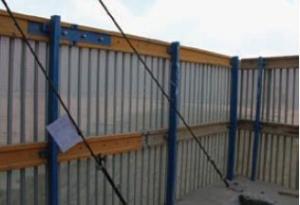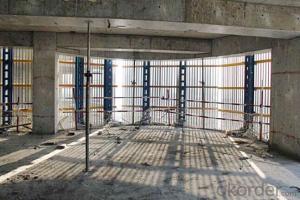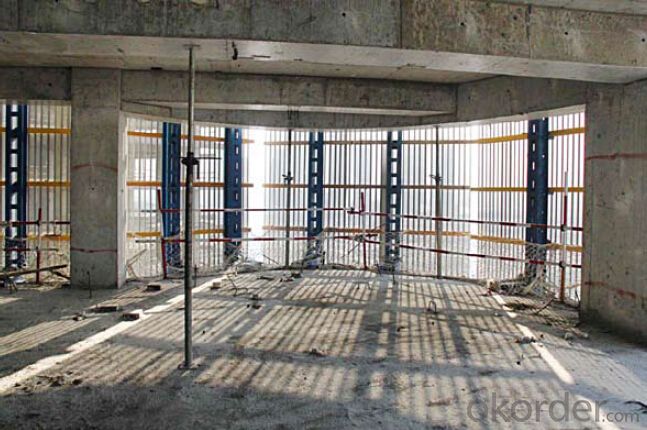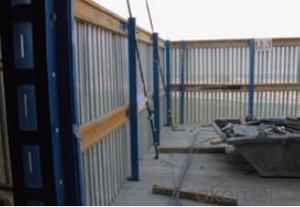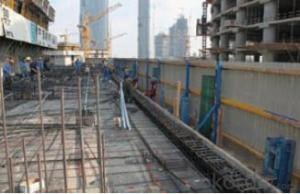Protection Platform for Formwork and Scaffolding Systems
- Loading Port:
- Tianjin
- Payment Terms:
- TT OR LC
- Min Order Qty:
- 50 m²
- Supply Capability:
- 1000 m²/month
OKorder Service Pledge
OKorder Financial Service
You Might Also Like
Protection Platform PP-50
A kind of new type construction protection system, applying operating platform and safer job
location for construction corps.
Characteristics:
◆ Easy and quick assembling.
◆ Lifted as a group, it is rapid and economic.
◆ Auto-climbing
◆ A safe and reliable anchor system
1. Composition
2. Assembly process of anchor system
(1) Embed V-climbing cone and anchor plate into the slab.
(2) Fix anchor shoe on the slab by tensile bolt.
(3) The fixed anchor shoe.
◆ High work efficiency with work platform and unload platform
◆ High light transmittance with the hollow block
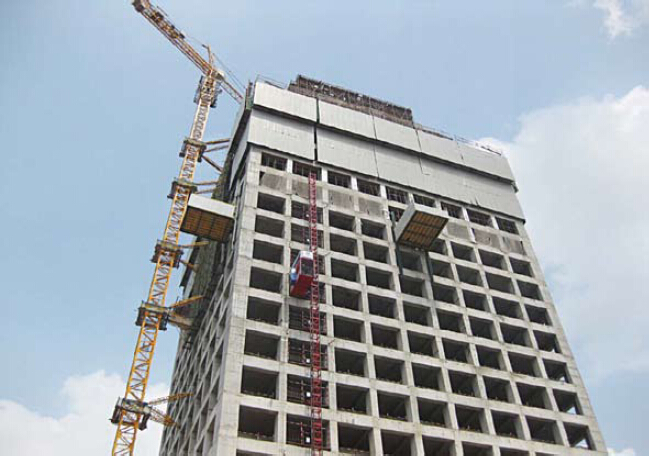

- Q: How does steel formwork accommodate for different concrete compaction methods?
- Steel formwork is an adaptable construction material capable of accommodating various concrete compaction methods with ease. Its strength and rigidity are key advantages, allowing it to withstand the forces exerted during compaction techniques. When utilizing compaction methods such as hand tamping or a vibrating poker, steel formwork provides a stable and secure surface for applying the necessary forces. The rigid and tightly connected steel panels ensure that the concrete remains in place and maintains its shape throughout the compaction process. This facilitates efficient and effective compaction, resulting in a uniform and high-quality concrete finish. In instances where mechanical compaction methods such as plate compactors or vibrating rollers are employed, steel formwork readily adapts to the added weight and vibrations. The robustness of the steel panels enables them to support heavy equipment and absorb vibrations without deformation or cracking. This guarantees even compaction of the concrete, eliminating any potential weak spots or voids. Moreover, steel formwork can be easily adjusted and modified to accommodate diverse compaction methods. The panels can be effortlessly repositioned or removed to allow proper access and movement for compaction equipment. Additionally, steel formwork can be tailored to specific shapes and sizes to meet the requirements of the compaction method employed. In summary, steel formwork offers a dependable and flexible solution for accommodating various concrete compaction methods. Its strength, rigidity, and adaptability make it an ideal choice for construction projects that necessitate efficient and effective compaction techniques.
- Q: Can steel formwork be used for railway construction projects?
- Yes, steel formwork can be used for railway construction projects. Steel formwork is a highly durable and versatile material that can withstand the heavy loads and pressures associated with railway construction. It provides a strong and rigid structure for pouring concrete and shaping the desired forms for railway infrastructure, such as tunnels, bridges, platforms, and retaining walls. Steel formwork offers several advantages for railway construction projects. Firstly, it has a high load-bearing capacity, allowing it to support the weight of the concrete and any additional loads. This is particularly important in railway construction, where safety and stability are paramount. Secondly, steel formwork is reusable, making it a cost-effective choice for large-scale projects. It can be easily dismantled, cleaned, and reassembled for future use, reducing the need for additional formwork materials and minimizing waste. Furthermore, steel formwork provides excellent dimensional accuracy and surface finish. It ensures that the concrete structures produced are of high quality and meet the required specifications and standards for railway construction. Additionally, steel formwork is highly resistant to moisture, chemicals, and other environmental factors that can degrade the formwork material. This makes it suitable for both indoor and outdoor railway construction projects, where exposure to harsh weather conditions is common. Overall, steel formwork is a reliable and efficient choice for railway construction projects. Its strength, reusability, dimensional accuracy, and resistance to environmental factors make it an ideal material for shaping and pouring concrete structures in railway infrastructure development.
- Q: Can steel formwork be used for fire-resistant concrete structures?
- Fire-resistant concrete structures can indeed utilize steel formwork. Steel possesses exceptional strength and heat resistance, rendering it an optimal choice for constructing formwork in such cases. Furthermore, steel formwork presents several benefits, including longevity, reusability, and effortless assembly and disassembly. By offering essential support and containment during the pouring and curing processes, it guarantees the integrity and safety of the structure in the event of a fire. Nevertheless, it is crucial to acknowledge that the fire resistance of the concrete itself is contingent upon factors like mix design, aggregate selection, and thickness, rather than relying solely on the formwork material.
- Q: How does steel formwork affect the overall energy efficiency of a structure?
- Steel formwork can significantly improve the overall energy efficiency of a structure. It provides a durable and reusable framework for concrete pouring, reducing material waste and construction time. The precise fit of steel formwork minimizes the need for additional insulation, resulting in better thermal performance and reduced energy consumption for heating and cooling. Additionally, its strength and stability allow for the construction of thinner walls and slabs, maximizing the usable space and minimizing the amount of materials required. Thus, steel formwork positively impacts the energy efficiency of a structure by reducing energy consumption and promoting sustainable construction practices.
- Q: How does steel formwork perform in fire-resistant structures?
- Steel formwork performs exceptionally well in fire-resistant structures. The inherent properties of steel, such as its high melting point and strength, make it an ideal material for withstanding high temperatures and structural integrity during a fire event. Firstly, steel formwork is non-combustible, meaning it does not contribute to the spread or intensity of the fire. It does not burn or release harmful gases when exposed to flames, unlike some other construction materials. This characteristic helps to prevent the rapid spread of fire within the structure, providing valuable time for evacuation and fire suppression. Moreover, steel has a high melting point compared to other materials commonly used in formwork, such as wood or plastic. This property allows steel formwork to maintain its structural integrity even when exposed to intense heat. It can withstand temperatures well above 1000°C (1832°F) without significant deformation or collapse, ensuring the stability of the structure and reducing the risk of sudden structural failure during a fire. Additionally, steel formwork has excellent load-bearing capabilities, even at high temperatures. This is crucial in fire-resistant structures as it allows the building to maintain its structural capacity when exposed to fire. The ability of steel formwork to bear the weight of the structure, even when compromised by fire, helps to prevent structural collapse and ensures the safety of occupants and emergency responders. Furthermore, steel formwork is durable and long-lasting, which is important in fire-resistant structures. It can withstand the effects of fire, such as thermal expansion and contraction, without significant damage. This durability ensures that the formwork can be reused or remain in place for future fire events, providing ongoing fire protection for the structure. In conclusion, steel formwork performs exceptionally well in fire-resistant structures. Its non-combustible nature, high melting point, load-bearing capabilities, and durability make it a reliable choice for maintaining the structural integrity and safety of the building during a fire.
- Q: How does steel formwork handle different concrete segregation tendencies?
- Steel formwork is highly effective in handling different concrete segregation tendencies due to its strength and durability. It provides a rigid structure that minimizes the risk of concrete segregation during the pouring and curing process. The smooth surface of steel formwork prevents the accumulation of excess water or aggregates, reducing the chances of segregation. Additionally, steel formwork can be easily adjusted and reinforced to accommodate varying concrete placement methods, ensuring uniform distribution and minimizing the potential for segregation.
- Q: How is steel formwork manufactured?
- Steel formwork is manufactured by cutting and shaping steel plates and bars according to the required dimensions and designs. These steel components are then welded together to form the desired formwork panels, beams, and columns. The steel formwork is further reinforced with additional steel bars and mesh, and the surfaces are treated to resist corrosion. Finally, the formwork is assembled and prepared for use in construction projects.
- Q: What are the different cost considerations associated with steel formwork?
- Some of the cost considerations associated with steel formwork include the initial purchase or rental cost of the formwork system, transportation and handling costs, installation and dismantling costs, maintenance and repair costs, and the potential for reusability and long-term cost savings compared to other formwork materials.
- Q: Can steel formwork be used for tunnel linings?
- No, steel formwork is typically not used for tunnel linings. Instead, materials like concrete or shotcrete are commonly used for tunnel linings due to their strength and durability.
- Q: Can steel formwork be used for both large and small-scale construction projects?
- Steel formwork is applicable to both large and small-scale construction projects, thanks to its durability, strength, and flexibility. Its versatility allows it to meet the diverse demands of construction projects. Both large and small-scale projects can benefit from its ease of customization and adjustment to meet specific requirements. Moreover, steel formwork's reusability contributes to its cost-effectiveness for both types of projects. Furthermore, it guarantees a smooth and high-quality finish for concrete structures, enhancing the desired aesthetic appeal of both large and small-scale construction projects.
Send your message to us
Protection Platform for Formwork and Scaffolding Systems
- Loading Port:
- Tianjin
- Payment Terms:
- TT OR LC
- Min Order Qty:
- 50 m²
- Supply Capability:
- 1000 m²/month
OKorder Service Pledge
OKorder Financial Service
Similar products
Hot products
Hot Searches
Related keywords
